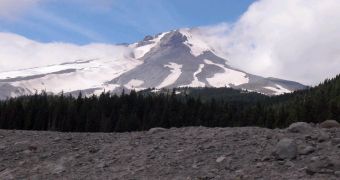Investigators from the Oregon State University (OSU) and the University of California in Davis (UCD) have recently determined what causes the historical eruptions of Oregon's tallest mountain, Mount Hood. The new data seems to indicate that a mixing occurring between two different types of magma may be responsible for the devastating events. The researchers also determined that it only takes weeks to months for eruptions to take place, after the mixing occurs. This is a very short period in geological terms, the group adds.
“These results clarify details of the processes that trigger Mount Hood eruptions. Similar triggering processes may occur in several of Earth's most active volcanoes,” says expert Sonia Esperanca. She is the program director of the Division of Earth Sciences at the US National Science Foundation (NSF), the organization that sponsored the investigation. What is really weird about the new conclusions is the fact that the behavior Mount Hood exhibits is different than that of Mount St. Helens, which is also part of the Cascade Range volcanoes.
“The data will help give us a better road map to what a future eruption on Mount Hood will look like, and what will take place before it occurs. It should also help us understand the nature of future eruptions and what risks they will entail,” OSU geoscience investigator Adam Kent argues. “The intense mixing of […] two types of magma causes an increase in pressure and other effects, and is usually the trigger for an eruption. But this process doesn't happen in all volcanic events. In the Cascade Range, Mount Hood appears to be one volcano where andesitic magma and recharge-driven eruptions are dominant,” he adds. Full details of the new investigation appear in the latest issue of the esteemed scientific journal Nature Geoscience.
One of the reasons why analyzing Mount Hood and its “neighbors” is so important is the fact that their magma chambers are connected to the Cascadia Subduction Zone reservoir. This area separates the Juan de Fuca and North American tectonic plates, which collide with each other here. This makes the area especially prone to volcanic activity and earthquakes, and researchers want to learn as much as possible about the ways in which various types of magma move underground. This could be extremely important for informing authorities on when the next violent eruption may occur in the area.

 14 DAY TRIAL //
14 DAY TRIAL //